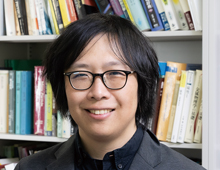Topological Materials Design Research Unit
Principal Investigator
- PI Name
- Motoaki Hirayama
- Degree
- Ph.D.
- Title
- Unit Leader
- Brief Resume
2013 Ph.D., Department of Applied Physics, University of Tokyo 2013 Postdoctoral Researcher, Nanosystem Research Institute, AIST, 2015 Project Assistant Professor, Department of Physics, Tokyo Institute of Technology 2017 Research Scientist, First-Principles Materials Science Research Team, RIKEN Center for Emergent Matter Science 2020 Unit Leader, Topological Materials Design Research Unit, RIKEN Center for Emergent Matter Science (-present) 2020 Project Associate Professor, Quantum-Phase Electronics Center, The University of Tokyo

Outline
In our unit, we explore novel materials and their properties using first-principles calculations, which are numerical methods for realistic materials. In particular, we focus on the topological properties of the electronic band structure and search for topological materials with non-trivial properties. We investigate the properties and applications of these unique electronic states. We also include superconducting states and propose the emergence of Majorana fermions. In addition, we develop ab initio methods to treat correlation effects and design a wide range of materials including strongly correlated systems and magnetic systems. We design materials across a wide range of fields, including materials in the chemical and materials fields, such as electrides.
Research Fields
Physics, Chemistry, Materials Science
Keywords
First-principles calculations
Theoretical materials design
Topological materials
Materials applications
Majorana fermions
Spin-orbit interaction
Results
Electrides as a New Platform of Topological Materials
Our unit propose e lectrides as a new platform of topological materials. Electrides are a group of materials in which electron e- exists in the interstitial region and stabilizes the structure as an anion. Electrides are being studied in the field of catalysis because of their small work function. For example, in the layered material Sc2C (Fig. (a)), electrons enter the cavities between the layers and exhibit insulating properties as shown in Fig. (b). The charge density of [Sc2C]2+2e– extends to interlayer positions that are significantly displaced from the Sc2C layer due to the anionic electrons 2e–, resulting in a non-trivial system with a quantized large polarization. Reflecting the bulk topology, a topologically-protected metallic state appears on the Sc2C surface (Fig. (c)). The metallic surface state originates from the interstitial electron, and therefore floats above the Sc2C surface (Fig. (d)). This electron cloud has a small work function, making it possible to use Sc2C as a topological substrate for high-density electron doping. For example, one electron per Mo site can be doped for MoS2 (Fig. (e)). We have discovered a variety of topological electrides including relativistic systems, which will lead to the development of topological properties across scientific fields.
Members
Motoaki Hirayama |
Unit Leader | motoaki.hirayama[at]riken.jp |
|---|
Publications
- M. Sato, J. Bouaziz, S. Sumita, S. Kobayashi, I. Tateishi, S. Blügel, A. Furusaki, and M. Hirayama
Commun. Mater. 5, 253 (2024)Ideal Spin-Orbit-Free Dirac Semimetal and Diverse Topological Transitions in Y8CoIn3 Family
- M. Hirayama, T. Nomoto, and R. Arita
J. Phys.: Condens. Matter 36, 275502 (2024)Topological band inversion and chiral Majorana mode in hcp thallium
- T. Tsuda, M. Sheng, H. Ishikawa, S. Yamazoe, J. Yamasaki, M. Hirayama, S. Yamaguchi, T. Mizugaki, and T. Mitsudome
Nat. Commun. 14, 5959 (2023)Iron phosphide nanocrystals as an air-stable heterogeneous catalyst for liquid-phase nitrile hydrogenation
- T. Yu, R. Arita, and M. Hirayama
Adv. Phys. Res. 2, 2200041 (2022)Interstitial-Electron-Induced Topological Molecular Crystals
- T. Hori, N. Kanazawa, M. Hirayama, K. Fujiwara, A. Tsukazaki, M. Ichikawa, M. Kawasaki, and Y. Tokura
Adv. Mater. 35, 2206801 (2022)A Noble-Metal-Free Spintronic System with Proximity-Enhanced Ferromagnetic Topological Surface State of FeSi above Room Temperature
- I. Tateishi and M. Hirayama
Phys. Rev. Research 4, 043045 (2022)Quantum spin Hall effect from multi-scale band inversion in twisted bilayer Bi2(Te1−xSex)3
- Y. Ohtsuka, N. Kanazawa, M. Hirayama, A. Matsui, T. Nomoto, R. Arita, T. Nakajima, T. Hanashima, V. Ukleev, H. Aoki, M. Mogi, K. Fujiwara, A. Tsukazaki, M. Ichikawa, M. Kawasaki, and Y. Tokura
Sci. Adv. 7, eabj0498 (2021)Emergence of spin-orbit coupled ferromagnetic surface state derived from Zak phase in a nonmagnetic insulator FeSi
- M. Hirayama, T. Tadano, Y. Nomura, and R. Arita
Phys. Rev. B 101, 75107 (2020)Materials design of dynamically stable d9 layered nickelates
- M. Hirayama, S. Matsuishi, H. Hosono, and S. Murakami
Phys. Rev. X 8, 031067 (2018)Electrides as a New Platform of Topological Materials
- M. Hirayama, R. Okugawa, T. Miyake, and S. Murakami
Nat. Commun. 8, 14022 (2017)Topological Dirac nodal lines and surface charges in fcc alkaline earth metals
- M. Hirayama, R. Okugawa, S. Ishibashi, S. Murakami, and T. Miyake
Phys. Rev. Lett. 114, 206401 (2015)Weyl Node and Spin Texture in Trigonal Tellurium and Selenium
Contact Us
Main Research Building 149, 2-1 Hirosawa, Wako, Saitama 351-0198 Japan
TEL:+81-(0)48-462-1111 (ext. 3168)
E-mail:
motoaki.hirayama[at]riken.jp

